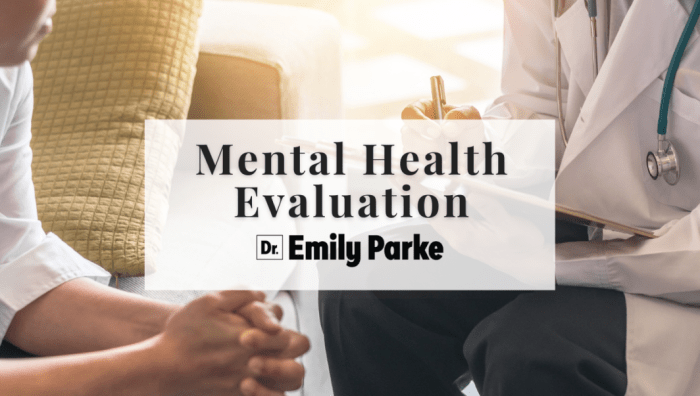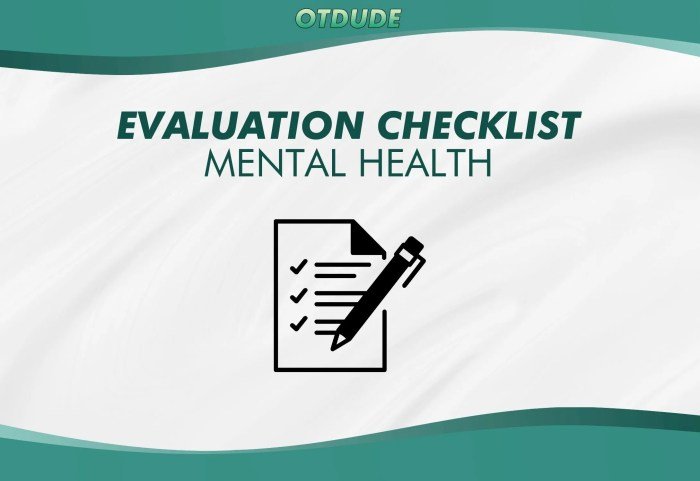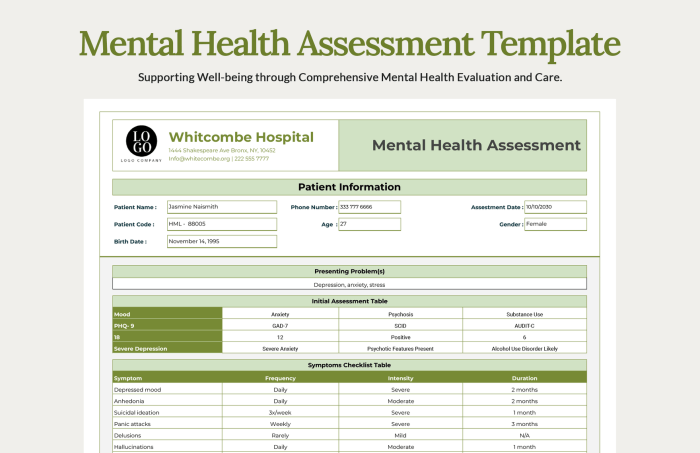Mental health status exams are a crucial tool for assessing an individual’s psychological well-being. They play a vital role in clinical settings, providing healthcare professionals with valuable insights into a patient’s mental state.
These exams are conducted in various situations, ranging from routine checkups to emergency room visits. They encompass a wide range of components, including the patient’s mood, thoughts, behavior, and cognitive abilities. The results of a mental health status exam can help identify potential mental health conditions, guide treatment decisions, and monitor progress over time.
Introduction to Mental Health Status Exams
Mental health status exams are a crucial part of evaluating an individual’s mental health. They are structured assessments designed to gather information about a person’s emotional, cognitive, and behavioral well-being. These exams help clinicians understand the nature and severity of mental health issues, enabling them to make informed diagnoses and develop effective treatment plans.
Purpose and Significance
Mental health status exams play a vital role in understanding a person’s current mental state. They provide a comprehensive snapshot of their emotional, cognitive, and behavioral functioning. By examining these aspects, clinicians can identify any signs of distress, dysfunction, or impairment that may require further investigation or intervention.
- Diagnosis:Mental health status exams help clinicians make accurate diagnoses by identifying specific symptoms and patterns of behavior associated with various mental health conditions.
- Treatment Planning:The information gathered from these exams guides the development of personalized treatment plans tailored to the individual’s needs and challenges.
- Monitoring Progress:Regular mental health status exams allow clinicians to track a patient’s progress throughout treatment and make adjustments as needed. This helps ensure that the treatment plan remains effective and addresses any emerging concerns.
- Research:Mental health status exams are also valuable tools for research, providing data on the prevalence and characteristics of various mental health conditions. This information helps researchers understand the causes, risk factors, and effective interventions for mental health issues.
Role in Clinical Settings
Mental health status exams are widely used in various clinical settings, including:
- Psychiatric Hospitals:These exams are essential for assessing patients admitted for acute mental health crises or ongoing mental health treatment.
- Outpatient Clinics:Mental health professionals conduct these exams during routine checkups and to monitor patients receiving ongoing treatment for mental health conditions.
- Primary Care Settings:Increasingly, primary care physicians are incorporating mental health status exams into their routine assessments to identify patients at risk for mental health problems.
- Schools and Universities:School counselors and university mental health services often use mental health status exams to screen students for mental health concerns and provide early intervention services.
Situations Where Mental Health Status Exams are Conducted
Mental health status exams are conducted in various situations, including:
- Initial Assessment:When a person first seeks mental health services, a comprehensive mental health status exam is conducted to gather baseline information about their current mental state.
- Routine Checkups:Regular mental health status exams are conducted to monitor patients’ progress and identify any changes in their mental health status.
- Medication Reviews:Mental health status exams are used to assess the effectiveness of medication and identify any potential side effects.
- Emergency Situations:In emergency situations, such as a suicide attempt or a severe mental health crisis, mental health status exams are conducted to assess the immediate risks and develop a plan for immediate intervention.
- Forensic Evaluations:In legal contexts, such as criminal proceedings or child custody cases, mental health status exams may be conducted to assess an individual’s mental state and capacity.
Components of a Mental Health Status Exam

A mental health status exam is a structured assessment of an individual’s current mental state. It is a crucial tool used by mental health professionals to gather information about a patient’s psychological well-being, identify potential mental health concerns, and guide treatment decisions.
The exam typically covers a range of aspects, from the patient’s appearance and behavior to their thought processes and emotional state.
Appearance and Behavior
This component focuses on the patient’s physical presentation and overall demeanor. It aims to assess their general appearance, hygiene, and any noticeable physical or behavioral characteristics that might be indicative of mental health issues.
A mental health status exam can help identify potential issues, but it’s important to remember that overall well-being involves more than just mental health. Taking time for self-care, like following a beauty routine like the ulta 21 days beauty program, can contribute to a sense of balance and positivity.
Ultimately, a comprehensive approach that includes mental health evaluation and self-care practices can lead to a more holistic sense of well-being.
Assessment Methods
- Observation:The clinician observes the patient’s appearance, including their dress, grooming, and posture. They also note any unusual movements, gestures, or mannerisms.
- Verbal Interaction:The clinician assesses the patient’s speech patterns, including their volume, rate, and clarity. They also pay attention to the content of their speech and any unusual language use.
- Motor Activity:The clinician observes the patient’s motor activity, noting any restlessness, agitation, or slowed movements.
Mood and Affect
Mood refers to the patient’s overall emotional state, while affect describes the outward expression of their emotions. This component aims to assess the patient’s current mood, its intensity, and how it fluctuates.
Assessment Methods
- Direct Inquiry:The clinician asks the patient to describe their mood, using questions like “How are you feeling today?” or “How would you describe your mood generally?”.
- Observation:The clinician observes the patient’s facial expressions, body language, and tone of voice to assess their affect. They note whether the affect is congruent with the patient’s reported mood and whether it is appropriate to the situation.
- Scale Assessment:The clinician may use standardized mood scales, such as the Beck Depression Inventory or the Hamilton Anxiety Rating Scale, to objectively measure the severity of the patient’s mood symptoms.
Thought Processes
This component examines the patient’s cognitive function and how they think. It aims to assess their clarity of thought, their ability to organize their thoughts, and any unusual or distorted thought patterns.
Assessment Methods
- Verbal Interaction:The clinician engages in conversation with the patient, paying attention to their thought processes. They assess the coherence, organization, and flow of the patient’s thoughts.
- Questioning:The clinician asks specific questions to assess the patient’s thought processes, such as “What are your thoughts about your current situation?” or “Can you tell me about your plans for the future?”.
- Cognitive Testing:The clinician may administer standardized cognitive tests, such as the Mini-Mental State Examination (MMSE), to assess the patient’s memory, attention, and executive function.
Sensorium and Cognition
This component focuses on the patient’s level of awareness, orientation, and cognitive abilities. It aims to assess their attention, memory, concentration, and ability to process information.
Assessment Methods
- Orientation:The clinician assesses the patient’s orientation to person, place, and time. They ask questions like “What is your name?” or “Where are you right now?”.
- Attention and Concentration:The clinician tests the patient’s attention and concentration using tasks like digit span or serial sevens.
- Memory:The clinician assesses the patient’s short-term and long-term memory by asking them to recall recent events or personal information.
- Cognitive Function:The clinician may administer standardized cognitive tests, such as the MMSE or the Montreal Cognitive Assessment (MoCA), to assess the patient’s overall cognitive function.
Insight and Judgment
Insight refers to the patient’s awareness and understanding of their own mental health condition. Judgment refers to their ability to make sound decisions and act in their own best interests.
A mental health status exam is a crucial step in understanding an individual’s well-being. It’s important to remember that mental health is just as important as physical health, and seeking professional help is a sign of strength. If you’re looking for resources to support your well-being, a beauty storefront might not be the first place you think to look, but there are many businesses and organizations that offer services and products that promote mental health and well-being.
So, don’t hesitate to reach out for help if you need it.
Assessment Methods
- Direct Inquiry:The clinician asks the patient about their understanding of their symptoms and their willingness to seek treatment. They may ask questions like “Do you think you have a mental health problem?” or “What do you think is causing your symptoms?”.
- Observation:The clinician observes the patient’s behavior and decision-making during the interview. They note whether the patient’s actions align with their understanding of their condition and their stated goals.
Perceptual Disturbances
This component examines the patient’s sensory experiences and whether they are experiencing any hallucinations or delusions.
Assessment Methods
- Direct Inquiry:The clinician asks the patient if they are experiencing any unusual sensory experiences, such as seeing, hearing, or feeling things that are not actually there. They may ask questions like “Have you been seeing or hearing things that others can’t see or hear?” or “Have you been having any unusual thoughts or beliefs?”.
- Observation:The clinician observes the patient’s behavior for any signs of perceptual disturbances, such as talking to themselves or responding to unseen stimuli.
Suicidal or Homicidal Ideation
This component assesses the patient’s risk of harming themselves or others.
Assessment Methods
- Direct Inquiry:The clinician asks the patient directly about any suicidal or homicidal thoughts or plans. They may ask questions like “Have you been thinking about harming yourself?” or “Have you been thinking about harming someone else?”.
- Risk Assessment:The clinician uses a structured risk assessment tool, such as the Columbia Suicide Severity Rating Scale (C-SSRS), to evaluate the patient’s suicide risk.
Substance Use
This component assesses the patient’s current and past substance use, including alcohol, drugs, and medications.
Assessment Methods
- Direct Inquiry:The clinician asks the patient about their substance use history, including the types of substances used, the frequency and amount of use, and any attempts to quit. They may ask questions like “Do you use alcohol or drugs?” or “Have you ever tried to quit using alcohol or drugs?”.
- Screening Tools:The clinician may use standardized screening tools, such as the Alcohol Use Disorders Identification Test (AUDIT) or the Drug Abuse Screening Test (DAST), to assess the patient’s risk of substance abuse.
Medical History
This component reviews the patient’s medical history, including any relevant physical health conditions or medications.
Assessment Methods
- Review of Medical Records:The clinician reviews the patient’s medical records to obtain information about their past medical history, current medications, and any relevant physical health conditions.
- Direct Inquiry:The clinician asks the patient about their medical history, including any chronic illnesses, recent surgeries, or medications they are currently taking.
Social History
This component explores the patient’s social support network, family history, and any significant life events that may have contributed to their current mental health status.
Assessment Methods
- Direct Inquiry:The clinician asks the patient about their social support network, family history, and any significant life events, such as trauma, abuse, or major losses. They may ask questions like “Who do you live with?” or “What are your relationships like with your family and friends?”.
- Review of Records:The clinician may review relevant records, such as court documents or social services records, to obtain additional information about the patient’s social history.
Table of Components and Assessment Methods
| Component | Assessment Methods |
|---|---|
| Appearance and Behavior | Observation, Verbal Interaction, Motor Activity |
| Mood and Affect | Direct Inquiry, Observation, Scale Assessment |
| Thought Processes | Verbal Interaction, Questioning, Cognitive Testing |
| Sensorium and Cognition | Orientation, Attention and Concentration, Memory, Cognitive Function |
| Insight and Judgment | Direct Inquiry, Observation |
| Perceptual Disturbances | Direct Inquiry, Observation |
| Suicidal or Homicidal Ideation | Direct Inquiry, Risk Assessment |
| Substance Use | Direct Inquiry, Screening Tools |
| Medical History | Review of Medical Records, Direct Inquiry |
| Social History | Direct Inquiry, Review of Records |
Mental Health Assessment Tools

Mental health assessments are essential for diagnosing and managing mental health conditions. They involve gathering information about a person’s thoughts, feelings, and behaviors to determine their mental health status. Various standardized tools and instruments are used to facilitate this process, each with its strengths and limitations.
Standardized Tools for Mental Health Assessment
Standardized tools provide a structured and objective approach to mental health assessment. These tools are designed to be reliable and valid, meaning they consistently measure what they intend to measure and produce accurate results.
- Symptom Checklists and Rating Scales: These tools help individuals self-report their symptoms, often using a Likert scale (e.g., 1-5) to indicate the severity of their symptoms. Examples include the Beck Depression Inventory (BDI), Generalized Anxiety Disorder Scale (GAD-7), and Patient Health Questionnaire (PHQ-9).
- Structured Interviews: These are standardized interviews that guide clinicians through a series of questions to assess specific mental health conditions. Examples include the Structured Clinical Interview for DSM-5 (SCID)and the Mini International Neuropsychiatric Interview (MINI).
- Neuropsychological Tests: These tools assess cognitive function, including memory, attention, and executive functioning. Examples include the Wechsler Adult Intelligence Scale (WAIS), Trail Making Test, and Wisconsin Card Sorting Test.
- Projective Tests: These tests use ambiguous stimuli, such as inkblots or pictures, to elicit responses that reveal underlying thoughts, feelings, and motivations. Examples include the Rorschach Inkblot Testand the Thematic Apperception Test (TAT).
Comparing and Contrasting Assessment Tools
Different assessment tools have different strengths and limitations, making it important to select the appropriate tool for the specific situation.
| Tool Type | Strengths | Limitations |
|---|---|---|
| Symptom Checklists and Rating Scales | Easy to administer, cost-effective, provide a quantifiable measure of symptoms | Reliance on self-report, potential for bias, may not capture the full complexity of mental health conditions |
| Structured Interviews | Comprehensive assessment, standardized format, reliable and valid | Time-consuming, may be less flexible for individual needs, potential for interviewer bias |
| Neuropsychological Tests | Objective measure of cognitive function, can identify specific cognitive deficits | May be time-consuming and expensive, require specialized training to administer and interpret |
| Projective Tests | Can provide insight into unconscious thoughts and feelings, may be helpful in exploring complex cases | Subjective interpretation, potential for bias, lack of reliability and validity |
Categorization of Mental Health Assessment Tools
Mental health assessment tools can be categorized based on their focus:
- Mood Disorders: Tools like the BDI, PHQ-9, and Hamilton Depression Rating Scale (HDRS) are commonly used to assess mood disorders, such as depression and bipolar disorder.
- Anxiety Disorders: The GAD-7, Beck Anxiety Inventory (BAI), and Panic Disorder Severity Scale (PDSS) are frequently used to evaluate anxiety disorders, such as generalized anxiety disorder, panic disorder, and social anxiety disorder.
- Cognitive Disorders: Neuropsychological tests like the WAIS, Trail Making Test, and Mini-Mental State Examination (MMSE) are employed to assess cognitive function in individuals suspected of having cognitive disorders, such as dementia or Alzheimer’s disease.
- Personality Disorders: Tools like the Minnesota Multiphasic Personality Inventory (MMPI) and Millon Clinical Multiaxial Inventory (MCMI) are used to assess personality traits and disorders.
Interpretation of Findings

Mental health professionals carefully analyze the information gathered during a mental health status exam to understand the individual’s current mental state and identify potential diagnoses. They consider various factors, including the individual’s self-reported symptoms, their behavior during the exam, and their responses to specific questions.
Integrating Information from Different Components
The interpretation process involves integrating information from different components of the exam. For example, a patient’s report of feeling anxious and having difficulty sleeping may be supported by observations of fidgeting, rapid speech, and insomnia noted in the exam. This combined information helps paint a more complete picture of the patient’s mental state.
Examples of Interpreting Findings, Mental health status exam
- Depressive symptoms: A patient who reports feeling hopeless, having low energy, and experiencing changes in appetite may be exhibiting signs of depression. If these symptoms are persistent and interfere with their daily life, a diagnosis of major depressive disorder may be considered.
- Anxiety symptoms: A patient who reports feeling nervous, having difficulty concentrating, and experiencing physical symptoms like rapid heartbeat and sweating may be experiencing anxiety. If these symptoms are frequent and interfere with their ability to function, a diagnosis of generalized anxiety disorder may be considered.
- Psychotic symptoms: A patient who reports hearing voices or experiencing delusions may be experiencing psychotic symptoms. These symptoms can be indicative of various mental health conditions, including schizophrenia or bipolar disorder, and require further evaluation.
Ethical Considerations

Mental health status exams are crucial for providing accurate diagnoses and developing effective treatment plans. However, it’s essential to approach these exams with a strong ethical framework to ensure the well-being and rights of the individuals being assessed.
Potential Biases in Assessment
It’s important to be aware of potential biases that can influence assessment outcomes. These biases can stem from various sources, including the assessor’s personal beliefs, cultural background, or previous experiences.
- Confirmation Bias:This bias occurs when assessors seek out or interpret information in a way that confirms their pre-existing beliefs or hypotheses about the patient. For instance, an assessor might focus on information that supports a particular diagnosis while overlooking contradictory evidence.
- Cultural Bias:Different cultures have varying norms and expectations regarding mental health. Assessors must be mindful of these differences and avoid imposing their own cultural values on the patient. For example, some cultures may view certain symptoms as acceptable or expected, while others may consider them signs of mental illness.
- Gender Bias:Some mental health conditions are more prevalent in one gender than the other. Assessors must be cautious about making assumptions based on gender stereotypes. For example, depression is often associated with women, but men can also experience depression, and their symptoms may manifest differently.
Confidentiality and Patient Autonomy
Maintaining confidentiality and respecting patient autonomy are fundamental ethical principles in mental health assessment.
- Confidentiality:Information disclosed by patients during mental health status exams should be kept strictly confidential. This includes protecting patient records from unauthorized access and ensuring that information is shared only with those involved in their care.
- Patient Autonomy:Patients have the right to make decisions about their own healthcare, including whether or not to participate in a mental health assessment. Assessors should obtain informed consent from patients before proceeding with any assessment procedures. This includes explaining the purpose of the assessment, the potential risks and benefits, and the patient’s right to refuse participation.
Mental Health Status Exams in Different Settings
Mental health status exams are conducted in a variety of settings, each with its own unique considerations and purposes. The specific focus and scope of the exam may vary depending on the setting, the patient’s presenting concerns, and the goals of the assessment.
Hospitals
Mental health status exams in hospitals are often conducted in emergency departments, inpatient units, or specialized psychiatric units. The focus of these exams is typically on identifying and addressing acute mental health concerns, such as suicidal ideation, psychosis, or severe anxiety.
The exam may also be used to monitor the patient’s response to treatment or to assess their risk of harm to themselves or others.
In hospital settings, the mental health status exam is often used to make rapid decisions about treatment and to ensure the safety of the patient and others.
Clinics
In outpatient clinics, mental health status exams are used to diagnose and treat a wide range of mental health conditions. The exam may be more comprehensive than in a hospital setting, allowing for a more detailed exploration of the patient’s history, symptoms, and functioning.
The exam may also be used to monitor the patient’s progress over time and to adjust treatment as needed.
Outpatient clinics offer a more structured setting for ongoing mental health care, enabling clinicians to comprehensively assess and manage conditions over time.
Schools
Mental health status exams in schools are often used to identify students who may be at risk for mental health problems or who are experiencing difficulties in school. These exams may be conducted by school counselors, psychologists, or other mental health professionals.
The focus of the exam is typically on assessing the student’s emotional, behavioral, and social well-being.
A mental health status exam can be a valuable tool for understanding an individual’s overall well-being. It can also help identify any potential issues that may need to be addressed. A balanced approach to mental health can involve finding ways to manage stress and improve mood.
Activities like attending a beauty barre class can provide a great way to de-stress and release endorphins, which can positively impact mood and overall mental well-being.
School settings provide a platform for early identification and intervention, potentially preventing the escalation of mental health issues and promoting academic success.
Examples of Specific Applications
- A patient presents to the emergency department with suicidal thoughts. The mental health status exam will focus on assessing the patient’s risk of suicide and developing a safety plan.
- A child is referred to a school counselor for behavioral problems. The mental health status exam will assess the child’s emotional and social functioning, and may identify potential underlying mental health conditions.
- A patient is being treated for depression in an outpatient clinic. The mental health status exam will be used to monitor the patient’s progress, assess their response to treatment, and make adjustments as needed.
Future Directions

The field of mental health status exams is continuously evolving, driven by technological advancements, shifting paradigms in mental health care, and a growing understanding of the complexities of mental illness. This evolution presents exciting opportunities to enhance the accuracy, efficiency, and accessibility of mental health assessments.
Emerging Trends and Innovations
The landscape of mental health assessment is undergoing a transformation, with new technologies and approaches emerging to address the challenges of traditional methods. Here are some key trends:
- Digital Mental Health Assessment Tools:Digital platforms are becoming increasingly prevalent in mental health assessment. These platforms offer a range of features, including:
- Automated Questionnaires and Screenings:Online questionnaires and screening tools can be administered quickly and efficiently, allowing for large-scale assessments and early identification of mental health concerns.
For example, the PHQ-9 (Patient Health Questionnaire-9) and GAD-7 (Generalized Anxiety Disorder-7) are widely used online screening tools for depression and anxiety, respectively.
- Mobile Apps for Mental Health Monitoring:Mobile applications can track mood, sleep patterns, and other relevant data over time, providing valuable insights into an individual’s mental well-being. Apps like “Daylio” and “Moodpath” allow users to log their mood, activities, and other factors that may influence their mental health.
- Virtual Reality (VR) Simulations:VR technology is being explored as a tool to create realistic simulations of real-life situations that trigger anxiety or stress. This allows clinicians to assess individuals’ responses to specific triggers in a safe and controlled environment.
- Automated Questionnaires and Screenings:Online questionnaires and screening tools can be administered quickly and efficiently, allowing for large-scale assessments and early identification of mental health concerns.
- Artificial Intelligence (AI) in Mental Health Assessment:AI is being used to analyze large datasets of mental health information, identify patterns, and develop predictive models. This has the potential to improve the accuracy and efficiency of mental health assessments. For example, AI algorithms can be used to analyze speech patterns, facial expressions, and other nonverbal cues to detect signs of depression or anxiety.
- Personalized Mental Health Assessments:The focus is shifting towards tailoring assessments to individual needs and preferences. This involves using personalized questionnaires, incorporating individual factors like cultural background and personal experiences, and leveraging data from wearable devices to provide a more holistic understanding of mental health.
End of Discussion: Mental Health Status Exam

Understanding the intricacies of mental health status exams is essential for healthcare professionals and individuals alike. By recognizing the purpose, components, and ethical considerations associated with these assessments, we can foster a more informed and compassionate approach to mental health care.
As technology continues to advance, we can anticipate even more sophisticated tools and techniques for evaluating mental health, further enhancing our ability to support individuals in their pursuit of well-being.
Frequently Asked Questions
What is the difference between a mental health status exam and a psychological evaluation?
A mental health status exam is a brief assessment used to screen for potential mental health issues. A psychological evaluation is a more comprehensive assessment that includes in-depth testing and analysis.
Are mental health status exams confidential?
Yes, mental health status exams are confidential, and the information shared during the assessment is protected by privacy laws.
How long does a mental health status exam typically take?
The duration of a mental health status exam varies depending on the complexity of the assessment, but it typically lasts between 15 minutes and an hour.